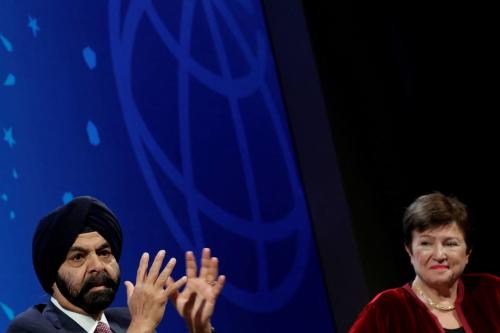There are now some 9 million Syrian refugees and it is estimated that 5,000 additional refugees are created every day. Over 5 million Syrians reside in neighboring countries, principally Jordan (800,000), Lebanon (1.8 million) and Turkey (1.8 million). Europe and the West have been largely closed to these refugees with desperate boat journeys the stuff of daily news items. The crisis is not abating, and with 2 million refugees in Iraq the problem is expanding. What is clear is that many of these refugees are unlikely to be going home soon, if ever.
The vast majority of Turkey’s Syrian refugees are not in camps but among the broader population; only 220,000 remain in camps. Turkey maintains its open border policy—most recently accepting some 160,000 Syrian Kurds from Kobani over a three-day period in October. Though rare, tensions between locals and Syrians do erupt occasionally, as low-skill wages are depressed, the cost of low-end housing increases, and Syrians get blamed for the increase in crime. These issues need to be addressed, and addressed in the context of the real challenge—avoiding a permanent refugee population that turns into an underclass.
As noted by Kemal Kirisci and Raj Salooja in Foreign Affairs, “the Syrians in Turkey are no longer refugees waiting for the war to end but…immigrants ready to write a new chapter in their lives.” Following four years of temporary protection under the nebulous designation “guests,” refugees are now receiving identification cards granting them access to basic services like preventive health care and education. This stops short of official refugee status, which includes more rights, but is still a significant move in the right direction. Moreover, a proposal to regulate working conditions was submitted to the Council of Ministers, allowing Syrians to apply for work permits with their ID cards.
In the meantime, a burgeoning Syrian business community is emerging. Many are in Gaziantep, Kilis, and Urfa—cities bordering Syria. There are also fairly large Syrian middle-class communities in cities like Mersin, 300 kilometers from Syria. There, over 50,000 Syrians have established Syrian schools, hundreds of businesses, and other reminders of home. The old Istanbul neighborhood of Aksaray boasts a “Kucuk Halep” (small Aleppo) with Syrian restaurants, bookstores, movie houses and other businesses. Similar areas can be found in other urban centers.
In 2013, Syrians established 489 of the 3,875 foreign-owned firms out of the 49,000 firms established in Turkey. That number grew to 1,122 in 2014 when Syrians accounted for 26 percent of the 4,249 foreign firms out of a total of 54,000 established in 2014. A larger influx is expected in 2015 as Syrians use their new status to establish more businesses or formalize them. Many other firms operate informally while some use Turkish partners of convenience. Many also employ Syrian workers. Turkish officials are looking at special arrangements for Syrians to work in Syrian firms. The Syria Trade Office, a Mersin consultancy, estimates that some $10 billion in Syrian capital has entered Turkey since 2011.
Turkey’s links with Syria were growing rapidly before 2011 and the subsequent civil war. The removal of visa barriers in 2009-2010 between Turkey and Jordan, Lebanon and Syria led to economic agreements and activities promising much greater economic cooperation. The World Bank noted the potential of regional economic integration through two recent reports, one by Sibel Kulaksiz, et al. and the other by Elena Ianchovichina and Maros Ivanic. The war abruptly slowed this growth in trade, which was expected to go from $2.3 billion annually in 2010 to $5 billion by 2014. Also coming to an end at that time was the deepening in trade that had just begun.
Yet, the visa-free area has continued to expand as Turkey and Iraq lifted visa requirements in 2014. Iraqis are now the fourth largest owners of newly established foreign firms in Turkey. Trade with both Iraq and Syria is expected to further increase in 2015. The recent rapprochement with Iraq and the re-opening of the Iraqi economy to Turkish firms (until recently largely concentrated in the Kurdish region) should help. In the meantime, while trade with Syria, now at its 2010 level, is recovering, its content is different, with a focus on basic foodstuffs, construction material, etc. It also remains a far cry from the consumer durables and capital goods that were expected to dominate prior to the war. Still, it underlines that trade continues and the growing number of Syrian firms are key to maintaining and even strengthening these ties. The over 330 percent increase in Mersin’s 2014 trade with Syria and in other border cities is linked closely to Syrian firms there.
Nevertheless, life remains difficult for many refugees in Turkey as they try to adapt with language, yet another barrier. However, the resilience of Syrian workers and businesses and their legalization provides hope that Turkey may yet avoid a permanent refugee population and a persistent underclass. When peace comes, these links will undoubtedly serve both countries well. In the meantime, it would be useful to think about how the international community could support Syrian businesses in Turkey (as well as in their other countries of refuge). For example, the World Bank’s creative way of helping Syrian refugees by supporting local communities in Lebanon and Jordan could perhaps inspire similar programs for Syrian entrepreneurs and workers in need of new skills.



Commentary
Avoiding a Permanent Refugee Trap in Turkey
January 26, 2015